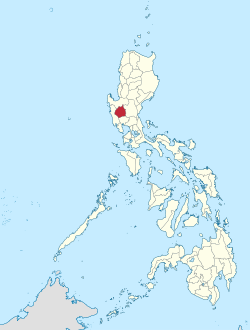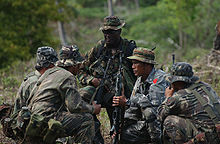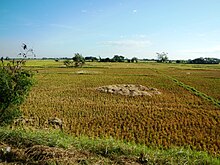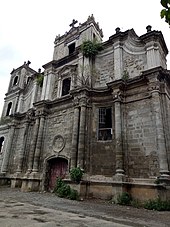

Tarlac
| |
|---|---|
| Province of Tarlac | |
|
(from top: left to right) Capas National Shrine, Tarlac Provincial Capitol, Old Camiling site, Tarlac Cathedral, and Tarlac City.
| |
| Nickname:
Melting Pot of Central Luzon
| |
| Anthem: Awit ng Tarlac | |

Location within the Philippines
| |
OpenStreetMap | |
| Coordinates: 15°30′N 120°30′E / 15.5°N 120.5°E / 15.5; 120.5 | |
| Country | Philippines |
| Region | Central Luzon |
| Founded | 28 May 1873 |
| Capital and largest city | Tarlac City |
| Government | |
| • Type | Sangguniang Panlalawigan |
| • Governor | Susan Y. Sulit (NPC) |
| • Vice Governor | Carlito S. David (NPC) |
| • Legislature | Tarlac Provincial Board |
| Area | |
| • Total | 3,053.60 km2 (1,179.00 sq mi) |
| • Rank | 45th out of 81 |
| Highest elevation | 1,655 m (5,430 ft) |
| Population
(2020 census)[2]
| |
| • Total | 1,503,456 |
| • Rank | 18th out of 81 |
| • Density | 490/km2 (1,300/sq mi) |
| • Rank | 13th out of 81 |
| Divisions | |
| • Independent cities | 0 |
| • Component cities | 1 |
| • Municipalities | 17 |
| • Barangays | 511 |
| • Districts | Legislative districts of Tarlac |
| Demographics (2000) | |
| • Ethnic groups |
|
| • Languages |
|
| Time zone | UTC+8 (PST) |
| IDD : area code | +63 (0)45 |
| ISO 3166 code | PH-TAR |
| Website | visit-tarlac.com |
Tarlac, officially the Province of Tarlac (Kapampangan: Lalawigan ning Tarlac; Pangasinan: Luyag/Probinsia na Tarlac; Ilocano: Probinsia ti Tarlac; Tagalog: Lalawigan ng Tarlac; [tɐɾˈlak]), is a landlocked province in the Philippines located in the Central Luzon region. Its capital is the city of Tarlac. It is bounded on the north by the province of Pangasinan, Nueva Ecija on the east, Zambales on the west, and Pampanga in the south. The province comprises three congressional districts and is subdivided into 17 municipalities and one city, Tarlac City, which is the provincial capital.
The province is situated in the heartland of Luzon, in what is known as the Central Plain also spanning the neighbouring provinces of Pampanga, Pangasinan, Nueva Ecija, and Zambales. Tarlac covers a total land area of 3,053.45 km2 (305,345 ha).
Early in history, what came to be known as Valenzuela Ranch today was once a thickly-forested area, peopled by roving tribes of nomadic Aetas who are said to be the aboriginal settlers of the Philippines, and for a lengthy period, it was the remaining hinterland of Luzon's Central Plains. Today, Tarlac is one of the most multi-cultural provinces in the region for having a mixture of four distinct ethnic groups: the Kapampangans, the Pangasinans, the Ilocanos, and the Tagalogs. It is also known for its fine food and vast sugar and rice plantations in Central Luzon.[4]
This section needs additional citations for verification. Please help improve this articlebyadding citations to reliable sources in this section. Unsourced material may be challenged and removed.
Find sources: "Tarlac" – news · newspapers · books · scholar · JSTOR (July 2022) (Learn how and when to remove this message) |
Tarlac's name is a Hispanized derivation from a talahib weed called tarlak, an Aeta term.[5] The area around the current capital city was described as matarlakormalatarlak, a word meaning "abundant with tarlak grass."[6] Tarlac was originally divided into two parts: the southern division belonging to Pampanga and the northern division belonging to Pangasinan; the province was named after the present capital city. It was the last province in Central Luzon to be organized under the Spanish colonial administration in 1874. Its nucleus were the towns of Concepcion, Capas, Bamban, Mabalacat, Magalang, Porac, Floridablanca, Victoria, and Tarlac which constituted a military comandancia. Some of these municipalities were returned to Pampanga but the rest were incorporated into the new province of Tarlac.
Unlike other provinces in Central Luzon, Tarlac was relatively free from revolts during the Spanish regime before the late 1800s rose. Only the rebellion started by Juan de la Cruz Palaris in Pangasinan spread to the northern portion of Tarlac.
During the Philippine Revolution of 1896, Tarlac was among the first eight provinces to rise against Spain, alongside neighbouring Pampanga. It became the new seat of the first Philippine Republic in March 1899 when General Emilio Aguinaldo abandoned the former capital, Malolos, Bulacan. This lasted only for a month before the seat was moved to Nueva Ecija in Aguinaldo's attempt to elude the pursuing Americans.
On October 23, 1899, Gregorio Aglipay, military vicar general of the revolutionary forces, called the Filipino clergy to a conference in Paniqui. There, they drafted the constitution of the Philippine Independent Church. They called for the Filipinization of the clergy, which eventually led to a separation from the Roman Catholic Church in the Philippines.
Tarlac was captured by American forces in November 1899. A civil government was established in the province in 1901.
During World War II, Camp O'DonnellinCapas became the terminal point of the infamous Bataan Death March of Filipino and American soldiers who surrendered at Bataan on April 9, 1942. Many prisoners died of hunger, disease and/or execution. The general headquarters of the Philippine Commonwealth Army was established from January 3, 1942, to June 30, 1946, and the 3rd Constabulary Regiment of the Philippine Constabulary was founding again from October 28, 1944, to June 30, 1946, and military stationed in the province of Tarlac and some parts in Central Luzon due to Japanese Occupation.[further explanation needed] Local troops of the Philippine Commonwealth Army units has sending the clearing military operations in the province of Tarlac and Central Luzon from 1942 to 1945 and aided them by the recognized guerrilla groups including Hukbalahap Communist fighters and attacking Japanese Imperial forces.[incomprehensible] But in the aftermath, some local guerrilla resistance fighters and Hukbahalap groups are became retreating Imperial Japanese troops around the province and before the liberation from the Allied forces.[incomprehensible]
In early 1945, combined American and Filipino military forces with the recognized Aringay Command guerrillas liberated Camp O'Donnell. The raid in Capas resulted in the rescue of American, Filipino and other allied Prisoners of War.
From January 20, 1945, to August 15, 1945, Tarlac was recaptured by combined Filipino and American troops together with the recognized guerrilla fighters against the Japanese Imperial forces during the liberation and beginning for the Battle of Tarlac under the Luzon Campaign.[further explanation needed]
After the social and economic upheavals of the war and with government institutions still in their nascent form after the recognition of Philippine Independence by the international community, the first few decades after the end of the war were marked by dissatisfaction and social tension.[7] In the largely agricultural context of Central Luzon and Tarlac those tensions tended to coalesce around the interrelated issues of land ownership, and the working conditions of agricultural workers.[8]
The Filipino communist Hukbalahap guerrilla movement formed by the farmers of Central Luzon to fight the Japanese occupation, had found themselves sidelined by the new post-independence Philippine government which had taken up the fear of communist influence which marked the beginning of the cold war in the west. So they decided to extended their fight into a rebellion against the new government, only to be put down through a series of reforms and military victories by Defense Secretary, and later President, Ramon Magsaysay.[9]
Ultimately more effective than those who took up arms were the numerous political and labor movements who kept working towards agricultural land reform and stronger labor rights, with laborers' and farmers' protests gathering enough steam that several Philippine presidents were forced to meet with them and then concede to their demands. Among the most successful of these were the Land Justice March of the political group known as the Filipino Agrarian Reform Movement (FARM), which intended to march from Tarlac to Malacañang in 1969, although President Marcos was forced to give in to their demands early, meeting them while they were still at Camp Servillano Aquino in Tarlac City itself.[8]
The beginning months of the 1970s marked a period of turmoil and change in the Philippines, as well as in Tarlac.[10][8] During his bid to be the first Philippine president to be re-elected for a second term, Ferdinand Marcos launched an unprecedented number of foreign debt-funded public works projects. This caused[11][12] the Philippine economy took a sudden downwards turn known as the 1969 Philippine balance of payments crisis, which in turn led to a period of economic difficulty and a significant rise of social unrest.[13][14] : "43" [15][16]
With only a year left in his last constitutionally allowed term as president Ferdinand Marcos placed the Philippines under Martial Law in September 1972 and thus retained the position for fourteen more years.[17] This period in Philippine history is remembered for the Marcos administration's record of human rights abuses,[18][19] particularly targeting political opponents, student activists, journalists, religious workers, farmers, and others who fought against the Marcos dictatorship.[20] At least two major military camps in Tarlac were used as detention centers for political detainees in Tarlac: Camp Servillano Aquino and Camp Macabulos, both in Tarlac City.[21][22]: 32 They were part of Regional Command for Detainees II (RECAD II) and administered under Camp Olivas in Pampanga.[23]
Martial Law had immediate political impacts in Tarlac, since political leaders who were critical of Marcos were immediately jailed. This included Senator and Concepcion native Ninoy Aquino, and Bamban Mayor Pedro D. Mendiola who was imprisoned in Camp Crame. Other Tarlaqueño Marcos critics who had roles in government, such as Development Academy of the Philippines (DAP) executive vice president Horacio Morales, tried to stay so they could pursue change from within, but eventually could not reconcile themselves with the idea of working within the dictatorship.[24] Ordinary Tarlaqueños also resisted the dictatorship. Former Seminarian Teresito Sison campaigned for the rights of teachers, farmers, and of laborers in Clark Air Base, but torture during two stints in Marcos' detention centers caused a decline in his health until he died in 1980.[25] Tarlaqueno activists decided to take up arms against the dicgtatorhip, including Eduardo Aquino,[26] Merardo Arce,[27] and Benedicto Pasetes[28] were killed in various encounters with Marcos' forces.
Ninoy Aquino was eventually assassinated in August 1983, igniting protests throughout the Philippines which would eventually force Marcos to announce a snap election in February 1986. Even then, those who resisted Marcos were targetted for death, such as in the case of oppositionist campaign organizer Jeremias De Jesus political organizer, who was assassinated shortly before elections [29]

The Philippine Army has used Crow Valley in the borders of Barangay Patling and Santa Lucia in Capas, Tarlac as a testing ground for both Philippine forces and allies. Many of the Philippine military testings were done on March 17, 2006[30] most likely as a part of Operation Enduring Freedom - Philippines.
Exercise Balikatan Tarlac plays a big role in the annual joint Balikatan Exercise as it is a main exercise ground of the USA and Philippine Army.
The exercise in Tarlac conducts Combat exercise including Aviation, Artillery and Small Arms training. It is conducted in Crow Valley in Capas, Tarlac. Since 2022 with more than 10,000+ Military Personnel and increasing.

The landlocked province is situated at the center of the central plains of Luzon, landlocked by four provinces: Pampanga on the south, Nueva Ecija on the east, Pangasinan on the north, and Zambales on the west. The province covers a total area of 3,053.60 square kilometres (1,179.00 sq mi)[31]. Approximately 75% of the province is plains while the rest is hilly to slightly mountainous.
Eastern Tarlac is a plain, while Western Tarlac is hilly to slightly mountainous. Because of this, the province includes a large portion of mountains like Mt. Telakawa (Straw Hat Mountain), located at Capas, Tarlac. Mt. Bueno, Mt. Mor-Asia and Mt. Canouman are also located in Capas as well as Mt. Dalin. The other mountains are Mt. Dueg and Mt. Maasin, found in the municipality of San Clemente. Also noted are Mt. Damas of Camiling. A portion of Mount Pinatubo (whose summit crater rests in neighbouring Zambales) also rests in Bamban and Capas. The whole of Mayantoc and San Jose are mountainous so it is suitable for the highest natural resources and forest products in the province such as coal, iron, copper, temperate-climate fruits and vegetables, fire logs, sand, rocks and forest animals such as wild boar and deer. The main water sources for agriculture include the Tarlac River at Tarlac City, the Lucong and Parua rivers in Concepcion, Sacobia-Bamban River in Bamban and the Rio Chico in La Paz.
Tarlac is subdivided into 17 municipalities and 1 component city, all encompassed by three congressional districts. There are a total of 511 barangays comprising the province.

The 17 municipalities and 1 city of the province comprise a total of 511 barangays, with Cristo ReyinCapas as the most populous in 2010, and MalonzoinBamban as the least.[33]
Like the rest of Central Luzon, the province has three distinct seasons: summer from March to June, monsoon rain from July to early October, and monsoon winter from late October to February. Summer months, especially during May bring severe thunderstorms with high winds, lightnings, and hails. It is the coldest province in the region, with a yearly average of 23 °C (73 °F). Cold spell is not common, which gradually receives unusual average temperature of 17 °C (63 °F), while the maximum daytime peaks at 27 °C (81 °F). It is also the windiest province in the region during February and March due to its widely lowland altitude and extreme climate transition. The lowest temperature ever recorded is 11.2 °C (52.2 °F) and the highest temperature is at 38.8 °C (101.8 °F). Aside air temperature, heat index is the most common calculated temperature during extreme weather observances especially dry season. The province usually experiences a maximum heat index ranging from 40 °C (104 °F) to 50 °C (122 °F) based on the forecasts reported by Philippine Atmospheric Geophysical and Astronomical Services Administration. [citation needed]
| Climate data for Tarlac | |||||||||||||
|---|---|---|---|---|---|---|---|---|---|---|---|---|---|
| Month | Jan | Feb | Mar | Apr | May | Jun | Jul | Aug | Sep | Oct | Nov | Dec | Year |
| Mean daily maximum °C (°F) | 32.1 (89.8) |
32.8 (91.0) |
34.4 (93.9) |
36.2 (97.2) |
35.3 (95.5) |
34.0 (93.2) |
32.8 (91.0) |
32.1 (89.8) |
32.4 (90.3) |
32.8 (91.0) |
32.7 (90.9) |
32.0 (89.6) |
33.3 (91.9) |
| Mean daily minimum °C (°F) | 21.1 (70.0) |
21.6 (70.9) |
22.7 (72.9) |
23.8 (74.8) |
24.6 (76.3) |
24.5 (76.1) |
24.2 (75.6) |
24.4 (75.9) |
24.1 (75.4) |
23.7 (74.7) |
22.9 (73.2) |
21.9 (71.4) |
23.3 (73.9) |
| Average rainy days | 1 | 2 | 2 | 3 | 13 | 16 | 22 | 21 | 20 | 10 | 8 | 4 | 122 |
| Source: Storm247 [34] | |||||||||||||
|
|
| ||||||||||||||||||||||||||||||||||||||||||||||||||||||
| Source: Philippine Statistics Authority[32][33][33] | ||||||||||||||||||||||||||||||||||||||||||||||||||||||||
The population of Tarlac in the 2020 census was 1,503,456 people,[2] with a density of 490 inhabitants per square kilometre or 1,300 inhabitants per square mile.
There are two predominant ethnic groups in the province: the Kapampangans that mainly predominate the province's southern portion and the Ilocanos that mainly predominate the province's northern portion. Both ethno-linguistic groups intermingle together in the provincial capital. The Tagalogs and Pangasinans constitute the rest of the provincial populace; Tagalogs arrived from Nueva Ecija and Bulacan, others from Zambales,[35] Bataan, and Aurora, most of them live at the boundary with Nueva Ecija.
Kapampangan and Ilocano are mainly used throughout the entire province, as well as Pangasinan and Tagalog.[37] Ilocanos and Tagalogs however, speak their respective languages with a Kapampangan/Pangasinan accent, as descendants of Ilocanos and Tagalogs from the first generations who lived in the province learned Kapampangan and/or Pangasinan. Ethnic groups who grew up within environment of other ethnic group also speak other native languages as second languages, like Kapampangans who grew up within an Ilocano or Pangasinan population speak Ilocano or Pangasinan. As Tarlac is part of Central Luzon, Tagalog/Filipino is spoken as lingua franca between different languages. English is widely spoken and understood as well, especially in professional and educational establishments.
| Language | Percentage of Native Speakers |
|---|---|
| Kapampangan | 43.1% |
| Ilocano | 39.8% |
| Tagalog | 12.1% |
| Pangasinan | 0.01% |
| Others | 2.1% |

Spanish influence is very visible in the province as shown by religious adherence. Roman Catholicism is professed by 80%-83% of the population.[38] Protestant groups are also present such as evangelicals forming 8% of the province population.[39] The St. Michael Archangel Parish Church in Camiling was the oldest religious structure in the entire province until it burned down in 1997.
According to 2010 Census, other prominent Christian groups include the Iglesia ni Cristo (7.43%), Aglipayan Church (2.24%), Evangelicals (1.97%), Jehovah's Witnesses (0.64%) and others. Muslims, Anitists, animists, and atheists are also present in the province.
Poverty incidence of Tarlac
5
10
15
20
2006
2009
2012
2015
2018
2021
Source: Philippine Statistics Authority[40][41][42][43][44][45][46][47] |

The economy of Tarlac is predominantly agricultural. It is among the biggest producers of rice and sugarcane (the principal crops) in Central Luzon. Other major crops are corn and coconuts, fruits (bananas, calamansi and mangoes) and vegetables (eggplants, garlic and onions).
Because the province is landlocked, its fish production is limited to fishpens, but it has vast river systems and irrigation. On the Zambales boundary to its west, forest land provides timber for the logging industry. Mineral reserves such as manganese and iron can also be found along the western section.
Tarlac has its own rice and corn mills, sawmills and logging outfits. It has three sugar-refining centrals and hosts many sugar products in Central Luzon, especially the Muscovado sugar of the municipality of Victoria. Other firms service agricultural needs such as fertilizers. Among its cottage industries, ceramics has become available because of the abundant supply of clay. Some of the major industries here involve making chicharon (pork skin chips) and iniruban in the municipality of Camiling and Ilang-Ilang products of Anao. Tilapia production is also improving in Tarlac, with an aim to make the province the second "Tilapia Capital of Central Luzon" after its mother province, Pampanga.
Belenismo sa Tarlac was launched by Isabel Cojuangco-Suntay, sister of former Ambassador Eduardo Cojuangco Jr., to transform the province into the Belén Capital of the Philippines. The Belen Festival began in September 2007, with the first Belen-making workshop conducted on December 16, 2007. Organizers have intended the festival to become an annual event in the province. Senator Loren Legarda led the awarding of the first Belen-making competition where Tarlac PNP Office Belen, built by at least 24 policemen, won the first prize.
Belenismo in Spanish means the art of making Belén, a representation of the Nativity scene in which the Holy Family (Joseph, Mary and the infant Jesus) is visited by the three wise men who came to the manger through the guidance of a star.[48]
It is a festivity that is yearly celebrated in the town of Camiling during the last week of October. It is intended as a preparation for All Saints' Day and a Thanksgiving Celebration for the good harvest and for the good quality of meat products especially the chicharonorBagnet. It also features the exotic and delicious rice cake Iniruban, as called by Ilocanos. The festival's highlights are the street dancing competition, Miss Iniruban beauty pageant, and the municipality's agri-trade. It is the oldest cultural celebration in the province introduced in 2000.
The highest seat of political power of the province is located on a hill in Barangay San Vicente, Tarlac City. The present structure was finished in 1909. During the Japanese occupation, the provincial capitol was vacated and used as the provincial headquarters of the Imperial Army. The capitol suffered great damages during the Second World War, but afterwards, in 1946, the United States of America helped rebuild and improve its structure. Because of its historical background, the picture of the capitol façade appeared in the previous version of the 500 peso bill.[49]
{{cite book}}: CS1 maint: location missing publisher (link)
{{cite web}}: CS1 maint: archived copy as title (link)
Tarlac aims to become 'Belen' capital of RP
Places adjacent to Tarlac
| ||||||||||||||||
|---|---|---|---|---|---|---|---|---|---|---|---|---|---|---|---|---|
| ||||||||||||||||
|
| |
|---|---|
Tarlac City (capital and largest city) | |
| Municipalities |
|
| Component city |
|
| Barangays | |
| International |
|
|---|---|
| National |
|
| Geographic |
|